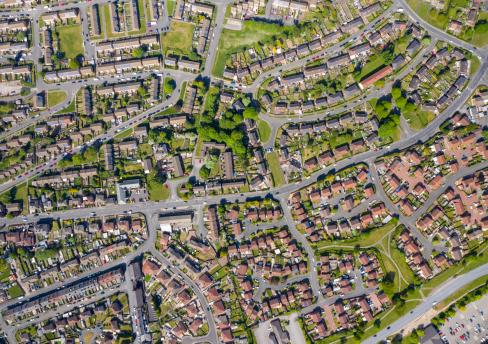
For purely selfish reasons, I've recently taken an interest in the law governing seagulls and property. A family of gulls has moved onto the flat roof above my tenement and for the last two months they've been the ornithological neighbours from hell. Even when they've decided to take a break from their blitzkrieg dive bombing campaign on residents and their hapless pets, their incessant squawking at all hours of the day and night is a constant reminder of our new noisy neighbours. And goodness knows what damage they're causing to the roof - we can't tell because no one can go up there without being attacked by the gulls aggressively protecting their nests.

And it's not just me….
It turns out I'm not the only one having problems. Year after year, more and more gulls are moving away from their traditional seaside environment towards centres of human population. It seems likely that the plentiful food supplies in towns and cities is the reason behind this shift, with street litter and landfill sites being the biggest draws. Safer nesting areas are also cited as a factor, with the gaps between chimney pots being attractive to Herring Gulls, while the Lesser Black-backed Gull prefers the large expanses of flat roofs above our industrial and commercial buildings (as these apparently resemble some of the flat cliffs on which they would traditionally have nested).
Unfortunately, our new neighbours don't always behave themselves as well as we might like them to. Gulls are at their most aggressive and vocal in the breeding season (which coincides with the summer months) where the "dive bombing" of people and pets who stray too close to nesting sites or fallen chicks has led to numerous injuries and even to fatalities.
Noise, littering and fouling by droppings (together with the public health concerns that go with these) also rank highly on the list of the gulls' anti-social behaviour with property damage also becoming an increasing issue. Not only will gulls happily pick away at roof materials with their sharp beaks, but they can also nest in areas designed for rain water run-off or gas flues, leading to substantial damage. This property damage is often exacerbated by the fact that it may not be possible to ascertain the extent of any damage or to carry out surveys or repairs due to the aggressive nature of the gulls.
Is there anything that under-siege owners, occupiers or property managers can do?
So, if you're having problems with gulls nesting on your property, what can you do about it? Well, probably not as much as you might like.
Section 1 of the Wildlife and Countryside Act 1981 provides that it is a criminal offence intentionally (or recklessly) to destroy, injure or capture any wild bird (including gulls) or their eggs. Further, it is an offence to damage or interfere with the nest of any wild bird while the nest is in use or being built. Penalties for a breach of this Section of the 1981 Act have the potential to be severe, with the maximum penalty for a conviction being a £5,000 fine and/or a six month prison sentence. So far, so good for the gulls!
However, there are certain exceptions to this general rule to help property owners deal with "pest" birds. Of most relevance to the issue of urban gulls are the "General Licences" that are issued each year by Scottish Natural Heritage (under delegated authority from the Scottish Government). These General Licenses are not issued to individuals, but instead can be relied upon by certain people (e.g., the owner of the property in question) to undertake certain specific acts that would otherwise be criminal offences under the 1981 Act.
These General Licences deal with varying issues such as preserving air safety (near airports) or preventing serious damage to livestock. However, the most relevant General Licence currently in force for commercial property owners and tenants is likely to be the "Licence to protect public health, public safety and prevent the spread of disease".
"Licensed to Kill" or not quite?
This particular General Licence permits the killing or taking of certain wild birds and taking or destroying of the nests and eggs of those birds for the purposes of "preserving public health, public safety and preventing the spread of disease". It applies to the Great Black-backed Gull, the Lesser Black-backed Gull and the Herring Gull (which make up the majority, but not all, of the urban gull population of Scotland). The General Licence prescribes the methods you can use and details the reporting requirements that apply.
Unfortunately, there is no consensus or guidance on what would meet the threshold for "protecting public health and public safety". The 1981 Act was brought in to give effect to the European Union Birds Directive (79/409/EEC), and so both the UK and Scottish governments are reluctant to give advice on this point that might constitute a breach of EU law. It seems likely that minor property damage and annoyance at noisy gulls would not qualify as a matter of "public health or public safety", but aggressive seagulls dive-bombing employees and members of the public may well meet the required threshold.
Even if you meet the requirement for preserving public health or public safety, there are other issues to be considered before action can be taken. First and foremost, the action should only taken where non-lethal methods of control are either ineffective or impractical. Further, it should be remembered that not all gulls are included in the current General Licence. While the three types of gull mentioned are the most likely culprits for urban nuisance, to the untrained eye, all species of gull appear similar and mis-identification could lead to a criminal breach of the 1981 Act.
Lastly, even in cases where action is legally justified under this General Licence, destruction of gulls and their nests is an emotive issue and can lead to adverse publicity, as happened earlier this summer following removal action at a Dundee supermarket.
Help from local authorities
Some local authorities are willing to assist with problem gulls. Dumfries and Galloway Council offer a free nest and egg removal service for commercial and residential properties during the breeding period (May to July) where there have been "issues of public health and safety (i.e., food stealing, dive-bombing and aggressive behaviour from the gulls)". Edinburgh Council offers a similar service for a fee but then only prior to any eggs hatching. While other Councils are following suit, many do not want to do anything that might run the risk of contravening the 1981 Act and choose not to get involved at all.
There are also question marks over the effectiveness of the Council schemes. Nests and eggs that are removed are soon replaced by more if the plentiful food sources and attractive nesting sites remain.
Prevention better than cure
Given the limitations and dangers inherent in the remedies listed above, more and more businesses are realising that prevention is far better than cure.
- Reducing the availability of food is seen as one of the key steps in encouraging gulls to take up residence elsewhere. There is evidence to suggest that the introduction of wheelie bins or gull-proof refuse sacks reduces gull numbers in that particular area.
- "Gull proofing" the roof of your property with suitable deterrent measures is also seen as vital tool in the battle to keep your property free from unwanted visitors. Aberdeenshire Council (among others) often make it a condition of planning approval that some level of mitigation is provided to prevent gulls from using the building in question for nesting.
Principal methods of deterrence are the fitting of spikes, wires and nets to prevent gulls landing. It should be remembered that the laws regarding alterations to listed buildings continue to apply so you should take legal advice on this point where required. It's also better to leave the installation of such measures to the professionals, as a poorly installed deterrent could injure a gull or other wild bird, putting you in breach of the 1981 Act.
It is worth bearing in mind that gulls are creatures of habit and will tend to return to the same nesting spot, year after year, unless dissuaded from doing so. Given that gulls can live up to 30 years or longer, it makes sense to take preventative action prior to the usual nesting season rather than attempting to deal with the various issues after the nests are in place.
The content of this webpage is for information only and is not intended to be construed as legal advice and should not be treated as a substitute for specific advice. Morton Fraser LLP accepts no responsibility for the content of any third party website to which this webpage refers. Morton Fraser LLP is authorised and regulated by the Financial Conduct Authority.









